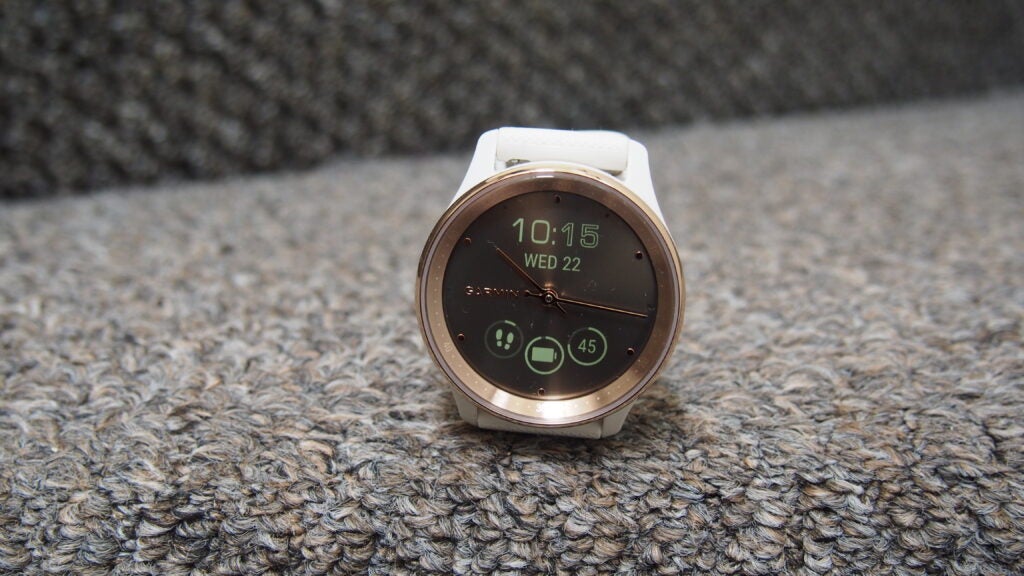Verdict
The Vivomove Trend fits in well with Garmin’s other hybrid smartwatches, offering a nice design and useful fitness, health and smartwatch features but it feels too close in price to the Vivomove Style, which offers more battery in watch mode and an AMOLED display.
Pros
- Great look
- Well integrated digital display
- Impressive array of fitness and wellness features
- Handy wireless charging
Cons
- Fiddly to get to some sub-menus
- Not your typical big Garmin battery life
- Higher quality displays on other Vivomove watches
- Not much cheaper than Vivomove Style
-
Analogue watch design:Combining a digital design with that of a traditional timepiece -
Garmin Pay and notifications:Smart features included on the watch itself -
Activity and sleep tracking:Wellness features are also available to keep an eye on your stress levels
Introduction
The Garmin Vivomove Trend is the latest addition to Garmin’s hybrid smartwatch family giving you a watch that sheds that typical sporty Garmin look for something that’s a bit more like a traditional timepiece.
Like the other Vivomove watches, it hosts a digital display that appears from behind the analogue watch face, letting you see features like activity tracking stats, heart rate and SpO2 readings and it lets you read through notifications as well as make contactless payments.
This is also the first Garmin watch to offer wireless charging, making it an easier smartwatch to power up than scurrying around for a charging cable. It sits below Garmin’s Vivomove Luxe hybrid in terms of pricing, putting it against similarly sleek hybrid watches like the Withings ScanWatch. The question is whether it gives you enough of those Garmin software goodies to match its more stylish design.
Design and screen
- Comes in three colour options
- 40mm case option only
- Built-in liquid crystal touchscreen display
- Waterproof up to 50 metres
A big part of why you’d want to wear the Vivomove Trend over other Garmin watches is how it looks. Like the other Vivomove watches, it gives you the combination of an analogue watch case and traditional watch face design, with a discreetly hidden display.
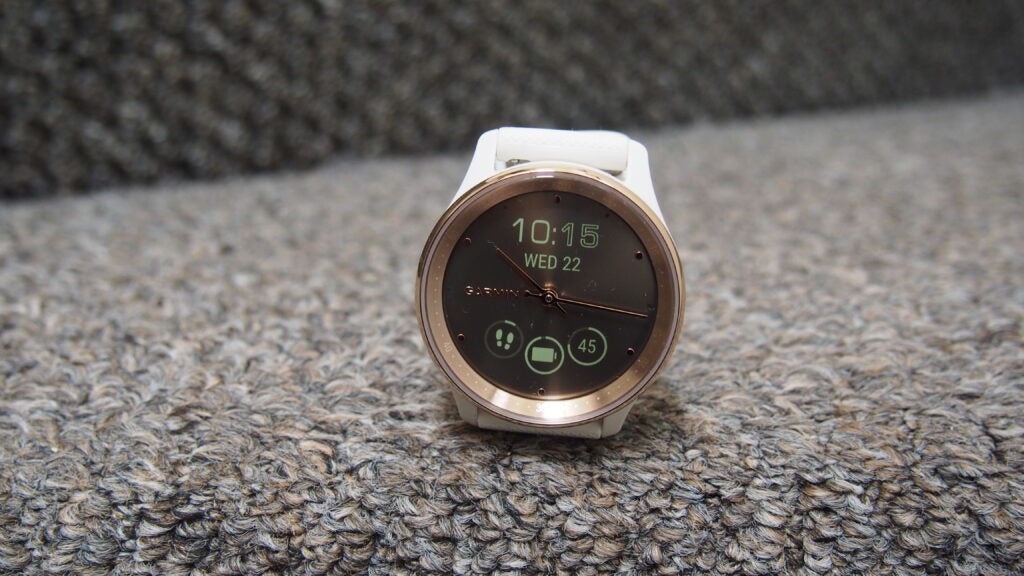
You don’t get the stainless steel or titanium case options like you do on the pricier Vivomove Luxe, but it does give you a far from wrist-hogging 40mm polymer case with a stainless steel bezel and a comfortable silicone strap that’s primed for being worn all day and night.
The Trend comes in three looks and I had the peach gold stainless steel bezel and ivory case combo to live with, which certainly felt like a look more suited to women. I actually quite like the look of it and it definitely doesn’t feel like your typical Garmin. The display that hides behind the analogue watch face is a 1.01-inch, 254 x 356 resolution liquid crystal display, so it isn’t the same OLED one you get on the Vivomove Sport or the AMOLED packed onto the Luxe and Style.
From a visibility point of view, it’s been fine in general to use indoors but a touch more challenging to use in bright outdoor light, though you do have the ability to adjust the display brightness in the settings. The responsiveness of the touchscreen is fine, but absolutely not perfect. You can tap, press and swipe and there have been occasions where I’ve had to swipe a couple of times to get through menu screens.
Like pretty much all of Garmin’s watches, it’s waterproof up to 50 metres depth making it suitable for swimming and showering. Flip the watch over and you’ll notice that it doesn’t use the same proprietary charging cable used on pretty much all new Garmin watches. Garmin has switched things up and uses what looks like one of the clip cables it used to bundle with its older Forerunner watches.
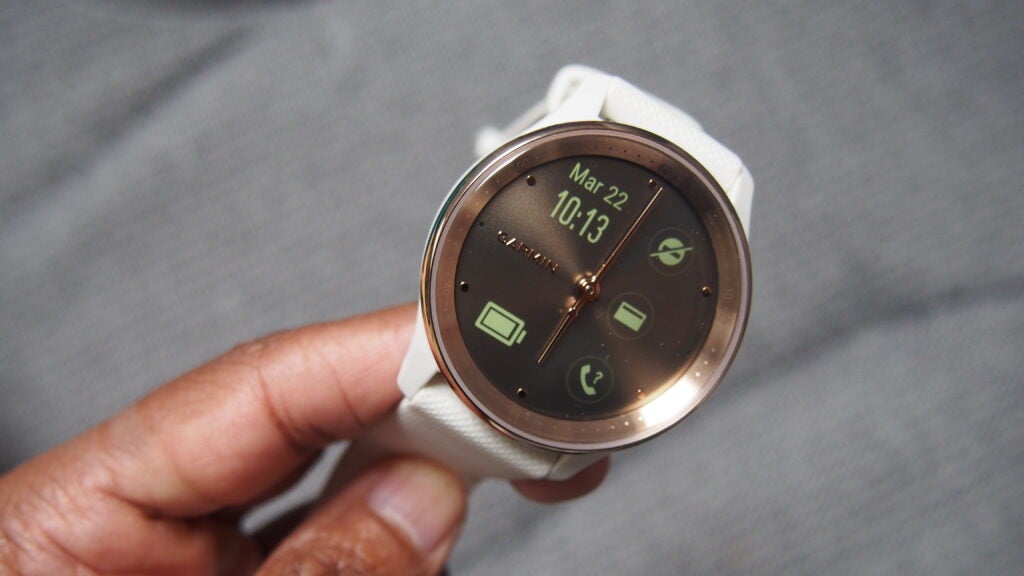
Software and smartwatch features
- Works with Android and iOS
- Garmin Pay
- Notifications
- No music player, Connect IQ support
With a mix of analogue and digital features, Garmin has sought to make the Vivomove work a little differently to a Forerunner or a Fenix. You don’t swipe down to see your Glances (widgets) stream and it does take some time to adjust to where things live, which does slow down the learning curve of effortlessly using the Trend.
It’s still heavily gesture based; swiping up from the watch screen to see full-screen sized widgets and down to see incoming notifications and messages you can expand to read. You can also swipe left and press down on the screen to get to the settings menu. It’s certainly not as intuitive as your standard Garmin, but the analogue hands thankfully never feel in the way as they dynamically move to make good use of the built-in digital screen.
Because of the slightly compromised form factor, you’d think that things like reading notifications or using music controls wouldn’t work as well as they do, but they do. When a notification comes through, it fills up the screen and you can scroll through them and it doesn’t feel like an awkward experience to do it. It’s the same story if you want to check your activity tracking progress and expand for additional detail or see your real-time stress measurements. There are other hybrid smartwatches that do a far worse job of merging the analogue and digital worlds together, so Garmin deserves some credit here.
It’s no surprise to find however that some Garmin smartwatch features don’t make the cut here. You can’t make calls, you can’t load music to listen to offline and you don’t have access to Garmin’s Connect IQ store, even just to throw on some different digital watch faces (though there are some additional ones in the Garmin Connect app). Still, it is nice to see that Garmin Pay does get included, and using the Vivomove Trend as a smartwatch actually works quite well.
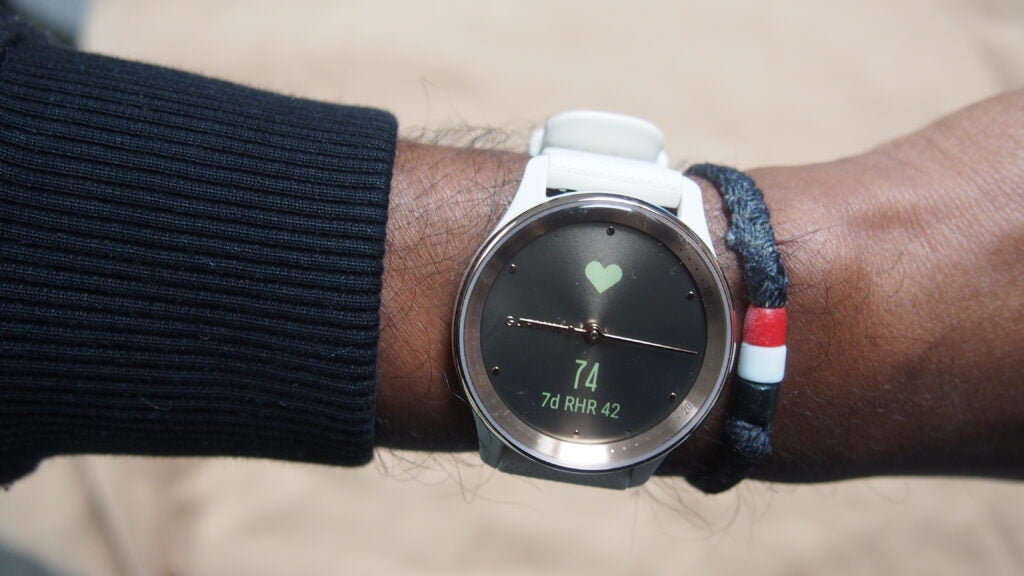
Fitness tracking
- Better for fitness and wellness tracking
- Connected GPS
- Preloaded sports apps
While the Vivomove Trend does have the ability to track sport, it’s unlikely to be the primary reason to grab it. This is a health, wellness and fitness tracker and from that perspective it does a very good job of it.
There’s both an optical heart rate monitor and a Pulse Ox sensor on board, and along with an accelerometer to track movement and detect sleep, it’s good to see there’s an altimeter to track elevation as well. From the watch, you can easily see daily step goals and how far you’re into meeting them – you’ll also get hit with prompts to move if you’ve been sitting down for too long. I used it alongside another Garmin watch, the Apple Watch Ultra and the Oura Ring 3 and found that daily step totals in general were within 200-300 steps of those trackers, so it’s a good showing on that front. You do get that useful auto goal mode here as well that adapts step goals based on you hitting or falling short of them each day.
It’s a tracker you can take to sleep as well, and up against the Oura Ring we found some common traits with Garmin’s tracking where it does still have the odd tendency to log an extra hour of sleep. Sleep stage breakdowns were in general pretty similar and it also delivered sleep scores consistent with the Oura as well.
In terms of monitoring your heart rate continuously, this is something that Garmin in general does a good job on, capturing reliable resting heart rate data and picking out high heart rate readings for the day. You’ve also got all-day stress tracking powered by heart rate variability measurements and respiration tracking that gives you something that can offer a collection of wellness stats for you to interpret and put to good use.
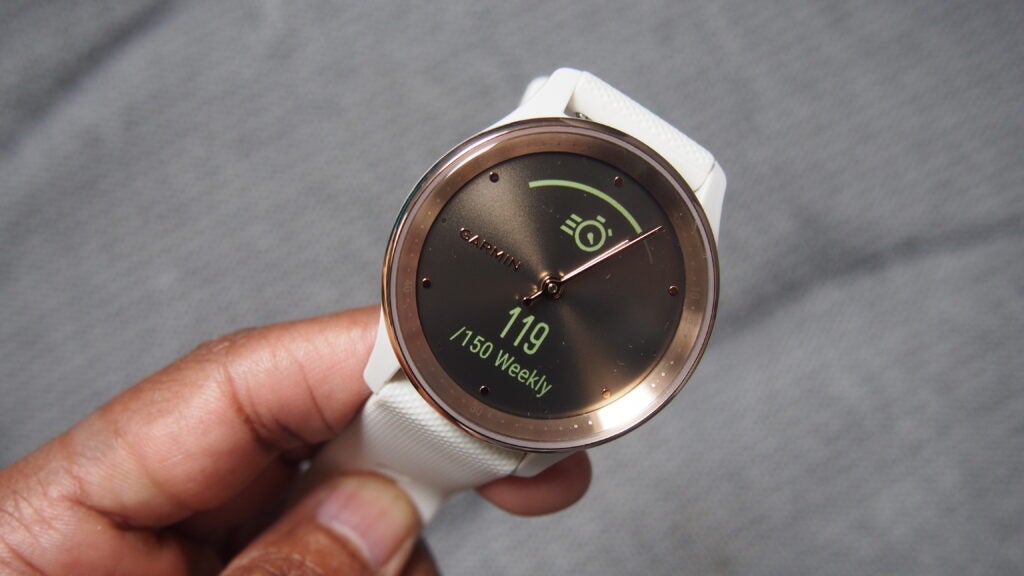
As mentioned, you can track workouts here too but it’s a more basic affair. You do have preloaded sports apps for running, cycling and swimming and for workouts like Pilates and Yoga, with support for automatic rep counting too. It’s an aspect of using the watch that feels a touch more fiddly though.
For outdoor runs, you need to use the connected GPS, and swim tracking only offers basic data in return. Using the display in that exercise mode though, we found metrics like pacing and distance tracking to be a touch off. You can absolutely use it to track workouts but it puts the combination of digital and analogue to the test as far as giving you an interface that easily communicates your progress.
Battery life
- Up to 5-days
- Up to 6-days with additional watch mode
- Wireless charging
The Vivomove Trend doesn’t buck the trend in terms of battery life that’s expected from other Vivomove watches. It’s up to 5-days in typical usage and that’s exactly what I found with my couple of weeks with the watch, using continuous health monitoring, reading notifications and tracking exercise indoors and outdoors. The watch does display battery status but not in the more useful percentage manner that would give you a better sense of how much battery you actually have left to play with.
Garmin does offer an additional day when using the Trend in watch mode, which is the same offered on the Vivomove Sport but less than the week offered on the pricier Luxe and Style watches. What you do get here that you don’t get on those other watches is wireless charging support. A wireless charger isn’t included alongside the proprietary charging cable however. Fortunately I had a wireless charging lamp and a Belkin charging stand designed for Apple’s devices and it worked absolutely fine on both.
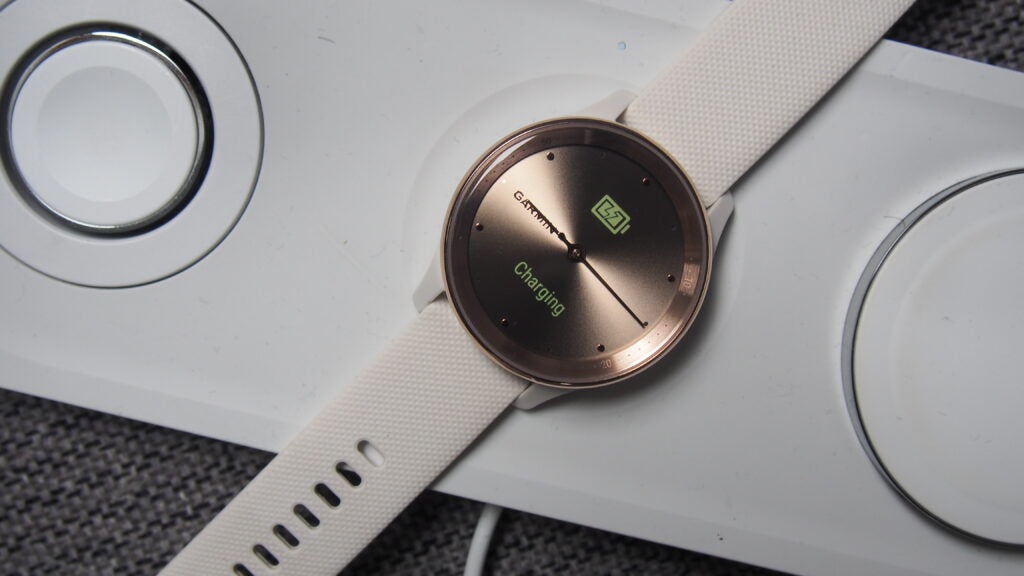
Should you buy it?
You want an attractive hybrid smartwatch for fitness tracking: The Vivomove Trend offers a good combination of looks and smarts that make it a largely enjoyable watch to live with.
You want the best hybrid smartwatch: The Vivomove Trend is an attractive, capable hybrid but you could get a lot of that experience from the cheaper Vivomove Sport and arguably get a sleeker analogue look from Withings too.
Final Thoughts
Garmin has shown with its Vivomove series that it can make a hybrid smartwatch work and offer useful features in an elegant and intuitive way. The question really is if the Trend is needed when there’s already three different Vivomove models and one of them sits quite closely in price and features, with the only major difference here being the inclusion of wireless charging.
FAQs
The Vivomove Trend doesn’t include a speaker or microphone needed to answer calls but you can accept and reject calls you’ll then need to answer on your paired smartphone.
The Vivomove Trend doesn’t have built-in GPS but does offer connected GPS support, which means it can use your phone’s GPS signal to track data like distance and pace more accurately.
Sustainability
TrustedReviews’ holds the fact that global warming is not a myth as a core value and will continuously endeavor to help protect our planet from harm in its business practices.
As part of this mission, whenever we review a product we send the company a series of questions to help us gauge and make transparent the impact the device has on the environment.
We currently haven’t received answers to the questions on this product, but will update this page the moment we do. You can see a detailed breakdown of the questions we ask and why in our sustainability info page.
Jargon buster
SpO2
An abbreviation for determining ‘blood oxygen saturation’, namely the levels of oxygen found within the bloodstream at any given time. A low SpO2 count can be the result of a serious illness.
BPM
An abbreviation of ‘beats per minute’, used to describe the pace of someone’s heartbeat as recorded by a smartwatch or some other wearable.
GPS
An abbreviation of the Global Positioning System, which uses satellite communication to pinpoint your location. Some smartwatches are able to achieve this communication without the use of a smartphone.

